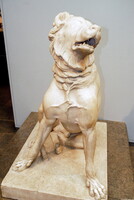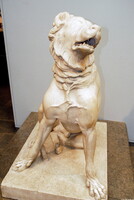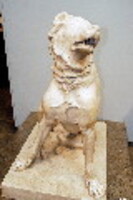| dc.coverage.spatial | Site: British Museum (London, England, United Kingdom) | en_US |
| dc.coverage.temporal | after 2nd century BCE- 1st century CE (creation) | en_US |
| dc.date | -100-100 | en_US |
| dc.date.accessioned | 2013-01-29T20:25:30Z | |
| dc.date.available | 2013-01-29T20:25:30Z | |
| dc.date.issued | -100-100 | en_US |
| dc.identifier | 189687 | en_US |
| dc.identifier.other | archrefid: 1757 | en_US |
| dc.identifier.uri | http://hdl.handle.net/1721.3/98223 | |
| dc.description | Overall view, looking down; Hellenistic realism extended to the expressive portrayal of animals as well as humans. Many bronze animal sculptures of this period are only known to us through Roman marble copies. The Molossi inhabited ancient Epirus (now northwest Greece and Albania). Molossian hounds were related to the modern mastiff and were famously fierce. They were often used a guard dogs by herdsmen and for the household security in cities. Aristophanes, the fifth-century comic dramatist, speaks of the hazards of trying to get past a doorway guarded by a Molossian dog, while the infamous Athenian statesman and general Alcibiades is said to have kept one with a docked tail. This dog once wore a collar. Its gaping jaws show powerful teeth, but the relaxed pose and upward gaze gave it an obedient air. Five other versions of this sculpture, all found near Rome, are thought to be Roman copies of a lost Greek bronze original, probably of the 2nd century BC. This version is sometimes known as the 'Jennings Dog', because it was once owned by Henry Constantine Jennings (1731-1819), who bought it in Rome in the 1750s. Source: British Museum [website]; http://www.britishmuseum.org (accessed 6/14/2009) | en_US |
| dc.format.medium | marble | en_US |
| dc.rights | © Scott Gilchrist, Archivision, Inc. | en_US |
| dc.subject | animals | en_US |
| dc.subject | dogs | en_US |
| dc.subject | guard dogs | en_US |
| dc.subject | herding dogs | en_US |
| dc.subject | Hellenistic | en_US |
| dc.subject | Greco-Roman | en_US |
| dc.title | Molossian Hound | en_US |
| dc.type | image | en_US |
| dc.rights.access | Licensed for educational and research use by the MIT community only | en_US |
| dc.identifier.vendorcode | 7A3-G-BM-MH-A1 | en_US |
| vra.culturalContext | Ancient Roman | en_US |
| vra.technique | carving (processes) | en_US |
| vra.worktype | sculpture (visual work) | en_US |
| dc.contributor.display | unknown (Ancient Roman sculptor, after Greek original) | en_US |



